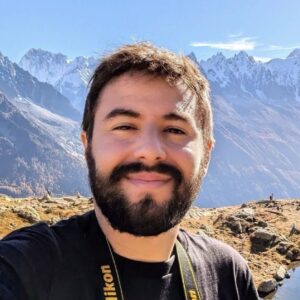Ezequiel Centofanti
PhD Student

| Contact Information | |
| E-mail: | ezequiel.centofanti [at] cea [dot] fr |
| Website: | https://centofantieze.github.io/ |
| Office: | 272 |
| Affiliation: | IRFU/DAp-AIM |
| Supervisors: | Samuel Farrens, Jean-Luc Starck |
About Me
I am a third-year PhD student working on machine learning (ML) and artificial intelligence (AI) methods for optical and radio astronomical imaging.
Research Interests
The goal of my PhD is to apply ML and AI techniques to address key challenges in astronomical imaging. In the era of multi-messenger astronomy, my work spans two wavelengths: optical and radio, tackling domain-specific challenges in imaging.
I am a member of the Euclid consortium, where I work on modelling the instrumental response of the Euclid telescope, known as the point spread function (PSF). The PSF describes how observed sources are distorted by imperfections in the telescope’s optical system. In the context of weak gravitational lensing (WL) studies—where galaxy shapes are measured and statistically analysed to constrain cosmological parameters—it is essential to characterise the PSF accurately. The novel WaveDiff model (Liaudat et al., 2023), a differentiable and data-driven approach, has been developed at CosmoStat in recent years. During my PhD, I contribute to the development and testing of new WaveDiff features, with the goal of applying the model to real Euclid observations. Furthermore, to enhance the capabilities of polychromatic PSF models such as WaveDiff, I proposed in my first year a method for stellar spectral classification from single wide-band images, increasing the number of stars available to train data-driven PSF models (Centofanti et al. 2024).
Challenges related to the point spread function (PSF) are not limited to optical imaging but also arise in radio interferometry, where signals from multiple antennas are combined to sample the spatial structure of the sky. In this context, the radio PSF—known as the dirty beam—is precisely determined by the antenna positions and the observing strategy, yet it exhibits a far more complex morphology than its optical counterpart. Imaging and deconvolution of interferometric observations has become a major challenge in astronomy due to the enormous data volumes produced by modern radio interferometers. As part of my PhD, I also collaborate with the ARGOS project, which aims to build a cutting-edge, affordable, and sustainable radio interferometer in Crete, Greece. To explore different antenna layouts and test reconstruction algorithms, I developed argosim (Centofanti et al., 2025), a Python package for radio interferometric simulations. The argosim package is lightweight, modular, and compatible with all major operating systems. Its computational backend is built on JAX, providing both significant performance acceleration, GPU compatibility and automatic differentiability.
I am currently working on radio weak gravitational lensing, where I am developing a generative forward model for cosmic shear measurements of radio galaxies. This model aims to overcome two major sources of bias in traditional shape measurements: (i) model bias arising from the parametric fitting of complex galaxy morphologies, and (ii) the limitations of using ellipticity as a tracer of shape for arbitrary galaxy profiles. My approach is to model the forward observation process of multiple galaxies within the same region of the sky, which share a common cosmic shear. By applying sampling algorithms such as Hamiltonian Monte Carlo (HMC), it becomes possible to directly infer the shear without relying on shape measurements of individual galaxies.
Education
I studied Electrical Engineering at the University of Buenos Aires. In 2020, I received the Eiffel Excellence Scholarship from the French government to complete my engineering degree in France, as part of a double-degree program at IMT Atlantique. In parallel with my engineering studies, I pursued a Master’s degree in Signal and Image Processing (SISEA), co-accredited by the University of Rennes and CentraleSupélec.
